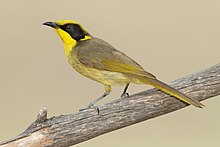Yellow-tufted honeyeater
| Yellow-tufted honeyeater | |
|---|---|

| |
| Scientific classification | |
| Domain: | Eukaryota |
| Kingdom: | Animalia |
| Phylum: | Chordata |
| Class: | Aves |
| Order: | Passeriformes |
| Family: | Meliphagidae |
| Genus: | Lichenostomus |
| Species: | L. melanops
|
| Binomial name | |
| Lichenostomus melanops (Latham, 1801)
| |

The yellow-tufted honeyeater (Lichenostomus melanops) is a passerine bird found in the south-east ranges of Australia. A predominantly black and yellow honeyeater, it is split into four subspecies.
Taxonomy
The yellow-tufted honeyeater was first described by the English ornithologist
Subspecies
Four races are recognised:
- L. m. cassidix, helmeted honeyeater, is restricted to a 5 km length of remnant bushland along two streams in the Yellingbo Nature Conservation Reserve, 50 km east of Melbourne, in Victoria. It is the brightest and largest subspecies, weighing 28–32 g (0.99–1.13 oz). In 2003, there were 103 individuals in the wild with 20 breeding pairs known, as well as a further 34 birds in captivity at the Healesville Sanctuary.[6]
- L. m. gippslandicus, Gippsland yellow-tufted honeyeater
- L. m. melanops, Sydney yellow-tufted honeyeater
- L. m. meltoni, inland yellow-tufted honeyeater, is smaller and duller in plumage with a smaller tuft, which was described by G. M. Mathews in 1912.[7]
Description
The yellow-tufted honeyeater is 17–23 cm (6.7–9.1 in) long, with females usually smaller.[8] It has a bright yellow forehead, crown and throat, a glossy black mask and bright golden ear-tufts.[9] The back is olive-green to olive-brown on wings and tail, and the underparts are more olive-yellow.[8][9] The bill and gape are black, eyes brown, and legs grey-brown.[10][11]
Distribution and habitat
The yellow-tufted honeyeater occurs from south-east
The helmeted honeyeater subspecies is largely restricted to dense vegetation along riverbanks, dominated by the mountain swamp gum (Eucalyptus camphora) with a dense understorey of woolly tea-tree (Leptospermum lanigerum), scented paperbark (Melaleuca squarrosa), saw-sedge (Gahnia), ferns and tussock grasses.[14][9][11]
Behaviour
Yellow-tufted honeyeaters are a noisy, active species in colonies from a few up to a hundred.[12] It aggressively defends territories around flowering trees.[12] It has a great variety of calls from a warbled "tui-t-tui-t-tui", a whistled "wheit-wheit", a sharp "querk" to a harsh contact-call "yip" or "chop-chop".[10][9][12]
Diet and Foraging
The diet of the yellow-tufted honeyeater is primarily
Breeding
Breeding takes place between July and March (mostly from September to January), with one or two broods each season.
Conservation
Yellow-tufted honeyeaters, as a species, are not listed as threatened on the Australian Environment Protection and Biodiversity Conservation Act 1999 or on any state-based legislation. However, at the subspecies level, the helmeted honeyeater (L. m. cassidix) is considered to be threatened:
- This subspecies is listed as endangered on the Australian Environment Protection and Biodiversity Conservation Act 1999.
- This subspecies is listed as
- On the 2007 advisory list of threatened vertebrate fauna in Victoria, the helmeted honeyeater is listed as critically endangered.[18]
References
- . Retrieved 12 November 2021.
- ^ Latham, John (1801). Supplementum indicis ornithologici sive systematis ornithologiae (in Latin). London: Leigh & Sotheby. pp. xl, xlix.
- ^ Salomonsen, F. (1967). "Family Maliphagidae, Honeyeaters". In Paynter, R.A. Jnr. (ed.). Check-list of Birds of the World (Volume 12). Vol. 12. Cambridge, Mass.: Museum of Comparative Zoology. p. 385.
- PMID 15263073.
- ^ Jobling, James A. (2010). "Helm Dictionary of Scientific Bird-names". Retrieved 2020-04-25.
- ^ a b Menkhorst P, Smales I, Quin B (2003). "Helmeted Honeyeater Recovery Plan 1999-2003". Australian Government, Department of the Environment and Water Resources. Retrieved 2007-06-21.
- ^ Mathews, G.M. (1912). A Reference-List to the Birds of Australia. Novit. Zool. 18: 171-455 [408]
- ^ ISBN 067087918-5.
- ^ ISBN 073222436-5
- ^ ISBN 085179813-6
- ^ a b c d e f g Higgins, P., L. Christidis, and H. Ford (2020). "Yellow-tufted Honeyeater (Lichenostomus melanops), version 1.0." In Birds of the World (J. del Hoyo, A. Elliott, J. Sargatal, D. A. Christie, and E. de Juana, Editors). Cornell Lab of Ornithology, Ithaca, NY, USA. https://doi.org/10.2173/bow.yethon3.01
- ^ ISBN 978174021417-9
- ^ "eBird map: yellow-tufted honeyeater". Retrieved 2020-04-26.
- ^ McMahon, A.R.G. and Franklin, D.C. (1993) "The significance of Mountain Swamp Gum for Helmeted Honeyeater populations in the Yarra Valley." Victorian Naturalist 110: 230-237.
- ISBN 0-646-42798-9.
- ^ Department of Sustainability and Environment, Victoria
- ^ Department of Sustainability and Environment, Victoria
- ISBN 978-1-74208-039-0.
External links
- BirdLife Species Factsheet
- Photos, audio and video of yellow-tufted honeyeater from Cornell Lab of Ornithology's Macaulay Library
- Recordings of yellow-tufted honeyeater from Graeme Chapman's sound library

